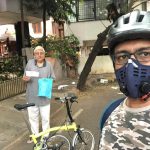

Take it seriously. Don’t bother with people who say that you are simply panicking as there are no deaths in India so far, and only about 74 people are infected. The reasons the counts are less could be because it takes 14 days for the virus to show up through symptoms, and by then imagine the number of people the patient could have come in touch with. The other problem is the issue of under-reporting. If you have mild symptoms, you might think it’s the common flu and self medicate. This is the case not just in India but across the world. Therefore, how do you distinguish between a common flu and COVID-19? While studies are ongoing, the early data points to fever and dry cough. Importantly, if you feel you have the virus due to your recent foreign travel or people you came in touch with, don’t rush to your family doctor, clinic or hospital? You could spread the virus to more people. Instead, just call the 24/7 helpline set up by the Ministry of Health & Family Welfare, Government of India. Call 011-23978046, and they will guide you with the next steps.
So what’s happening in China? Well, our source tells us that people who can work from home are doing so, while the others are getting to work with a face mask and sanitiser in hand – they have no option. People who get sick during this period stay home, while others continue to work. People who recover begin going to work, but some fall sick again as they suffer a relapse, and stay home again. It’s cyclical, but life has to go on.
The truth is that those affected are young people, and statistics point out that the elderly with pre-existing cardiovascular/hypertension/diabetes/respiratory issues are dying the most. However, this could change as the youngsters could come in contact with the elderly at home or at public gatherings. Therefore, desisting from non-essential travel anywhere within the city, country or outside is the best option. This gives time for the health services to take care of the existing patients and contain the spread. Imagine everyone falling sick and being treated on the hospital floor as there are no beds left. Also imagine the doctors plight who are understaffed and have to choose one patient to treat, and let the other to die. There aren’t too many ICU rooms to help patients with artificial respiration.
The number of cases in China are coming down because several cities were shutdown; that is the only way to contain this virulent virus. It’s all fine to say wear a mask and use a sanitiser, but when the humans are programmed to touch their face involuntarily, this is not an easy habit to inculcate overnight. The best way is to isolate yourself socially.
When the U.S. can under-test due to the lack of kits, what could be the plight of developing countries like India, which only has 52 screening centres in the country, and only one in Bangalore. To add to this, the doctors will treat them like normal flu and cold cases and that’s that. Clearly, there is under-reporting of cases and there is a wide gap between the official figures and the true number. When officials in Wuhan, the nerve centre of the virus, thought they had x number of cases, the actual figures went up by 27 times, if certain permutations and combinations are to be believed.
Lets come to the mortality rate. When it began, the number of people dying as opposed to those infected stood at about 2% in Wuhan. Today, it’s at 4.9% in Wuhan and 2.1% in the rest of China, and 3.4% everywhere else. The death rate is far from alarming if you compare with Severe Acute Respiratory Syndrome (SARS) at 9.6% and Middle East Respiratory Syndrome (MERS) at 34%.
All the COVID-19 calculations are based on official figures, not true figures. Once the pandemic ends, we could be closest to the actual picture. The best example of this was the 2003 WHO estimate of Severe Acute Respiratory Syndrome (SARS) fatality rate of 4% when the epidemic was ongoing, and later corrected to 9.6% when the disease ended its reign of terror. What is also disturbing is research suggesting that in some people, the infected person may never display any symptoms and end up infecting many more people. So is the WHO estimate of 3.4% mortality rate true? Well, American president Donald Trump suspects it’s less than 1% while Time magazine also suspects that the percentage might fall when more people are tested and the data gathering becomes more agile. BBC reports that under-reporting can work either way; the mortality rate could go up or come down. But what everyone is missing is that even if a person recovers from COVID-19, imagine the 14 days he has to be under lockdown just because he preferred to be a social butterfly or had urgent work to do. And also imagine how many people he might have spread the disease to. It is a mammoth loss of productivity, and that’s an economic loss for the entire world. Google understands that as they have access to data which most don’t. That they are asking every employee to work from home signals that things need to be taken seriously. And if you have to have people come in to work, atleast grant work-from-home (WFH) option to those who have cardiovascular, diabetes, hypertension, and respiratory disease. If you must narrow this number down as there are too many BP and diabetes patients in the workforce, atleast make WFH mandatory for those above 50 years of age as the mortality starts to shoot up after this age.
If you are running a business that depends on physical visits from your customers, what do you do? Well, get someone with a sanitiser to disinfect the customer the moment they walk in, and again when they walk out. Keep masks handy, so you can hand it to your employees or even customers the moment you spot them coughing. These may appear small steps, but they are essential if you want to assure your patrons that they are safe when they walk inside your office or showroom. And this is in your interest too. But what if you run a yoga class and your patrons don’t want to come for fear of the virus? Begin online classes if you haven’t done them already. Similarly, if you run an office, but need face time with employees on certain matters, do a video conference instead. Don’t risk it. The only way to contain the virus spread is social isolation. There aren’t so many ICUs and ventilators around to taken in hundreds and thousands of patients. By exercising caution and good hygiene, you save India from going the Italy way.



